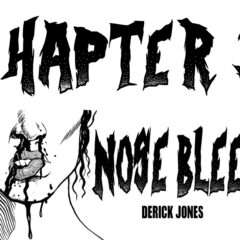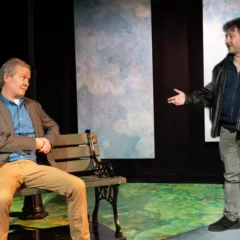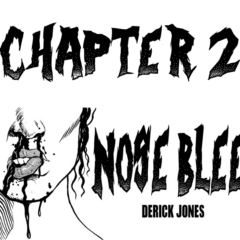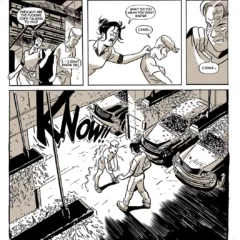An array of blood, gore, and violence in movies, television shows, and video games has long been a staple of American Pop culture and the nightly news, perhaps to the extent that the viewing public has become jaded to the mind-numbing repetition of the horrors they see. As Andy Warhol already lamented in the 1960s, “I’m afraid that if you look at a thing long enough, it loses all of its meaning.” But live theater is different. It is multi-dimensional, organic, and immediate; and when the blood flies in an intimate Philadelphia theater, you’re likely to get hit. It is art with an impact.
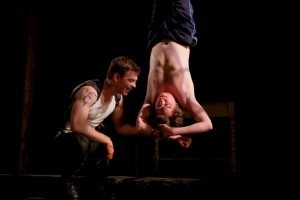
For Joe Canuso, the Artistic Director of Theatre Exile, known for its gritty, provocative, and dangerous work: “Violence is conflict, and conflict is theater; you can’t have two hours of people just saying ‘I love you’–that wouldn’t be a story.”
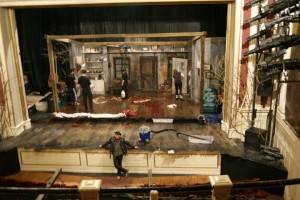
The types of violence portrayed in this season’s stories range from political to personal, and sexual to virtual, while the plays run the gamut from dramas to parodies and comedies. Collectively the offerings of EgoPo, Exile, Lantern, and Luna—four of the city’s most compelling companies–raise important issues about the human condition and its present state.

EgoPo launched its 2010-11 “Festival of Cruelty” with a stirring production of Marat/Sade, in which sexual depravity and insanity serve as metaphors for the moral decline of the French Revolution. Under the controlled direction of Brenna Geffers, the violence was less graphic and more psychological. EgoPo followed with Artaud Unbound, a collection of four short pieces that trace the deteriorating mental condition of the early 20th-century French writer. Again the visible acts of violence were kept to a minimum, and were replaced by Poe-like suspense, which may seem mild by today’s standards, but which exalted the powers of language and suggestion. And the cabaret-style seating, with cast members not just on stage but amidst the tables, brought the audience into personal proximity with aggression and instability.
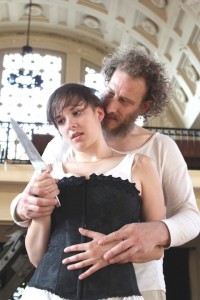

EgoPo concludes its season April 27-May 15, with an adaptation of Henri Barbusse’s Hell, a voyeuristic journey through a hole in the wall of a boardinghouse room, where private acts of marriage, birth, lesbianism, adultery, incest, and death are realistically exposed. The goal of Hell director Lane Savadove is to present honest events on stage, assuming “if the impulse is true, the audience will respond well.” In these troubled times, it is evident that violence is truth, and theater is a reflection of the world.
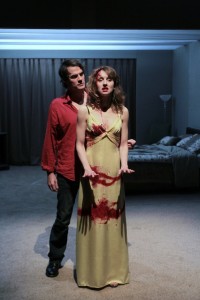
Two of the most graphically violent shows of the season were produced by Theatre Exile. Sheila Callaghan’s That Pretty Pretty, or The Rape Play brought to life a world of virtual violence as envisioned by a fictitious writer of our digital age. The no-holds-barred parody highlights the desensitization to murder, rape, and other vulgar anti-social behavior of a generation raised on computers, and becoming increasingly distanced from real human interaction. Exile’s current production of Martin McDonagh’s dark comedy, The Lieutenant of Inishmore (running through March 13, and part of the city-wide Irish Theatre Festival), is even more of a bloodbath. Its wholesale torture, slaughter, decapitation, and dismemberment, in which even pet cats are assassinated, use more than five gallons of stage blood for each performance and require a clean-up time of nearly two hours. Rooted in McDonagh’s own disgust with political terrorism in Ireland, he employs a comedic mode as a wake-up call to stop the lunacy of this unending conflict. With Exile’s consistently hilarious cast and uproarious direction by Matt Pfeiffer, the audience can’t help but laugh out loud at the ridiculous brutishness that pits villager against villager, and family member against family member. As one character notes, “It’s incidents like this does put tourists off Ireland”!
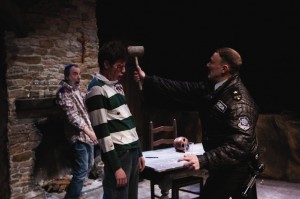
Lantern too participated in the Irish Festival with another of McDonagh’s black comedies, A Skull in Connemara. Here the farcical violence is domestic, fueled by alcohol, gossip, small-town claustrophobia, and tedium, and enabled by an all too accepting extended family and laughably incompetent police force. While smashing disinterred skeletons and each other with sledgehammers, the dysfunctional group enthusiastically reaffirms Aesop’s ancient maxim, “familiarity breeds contempt.”
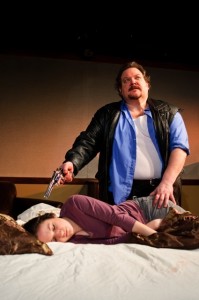
Luna’s production of Sarah Kane’s Blasted (extended through March 5) is the most gruesome of all, a microcosm of ubiquitous fear, and violence that begets violence, with no resolution but death. The manic-depressive playwright, who committed suicide at age 28, conjures up an apocalyptic vision of the struggle to survive in the worst of times, in which brutality is excessive, and mortality is a welcome relief from relentless suffering. Director Gregory Scott Campbell sees the play as “a much more extreme version of what many of us have had to survive with the ‘economic downturn’ of the past few years. I think we are all going through our Kubler-Ross stages of grief, including anger.”
If this powerful season can incite a dialogue about the vicious turn our world has taken, it will have been worth its weight in blood.


